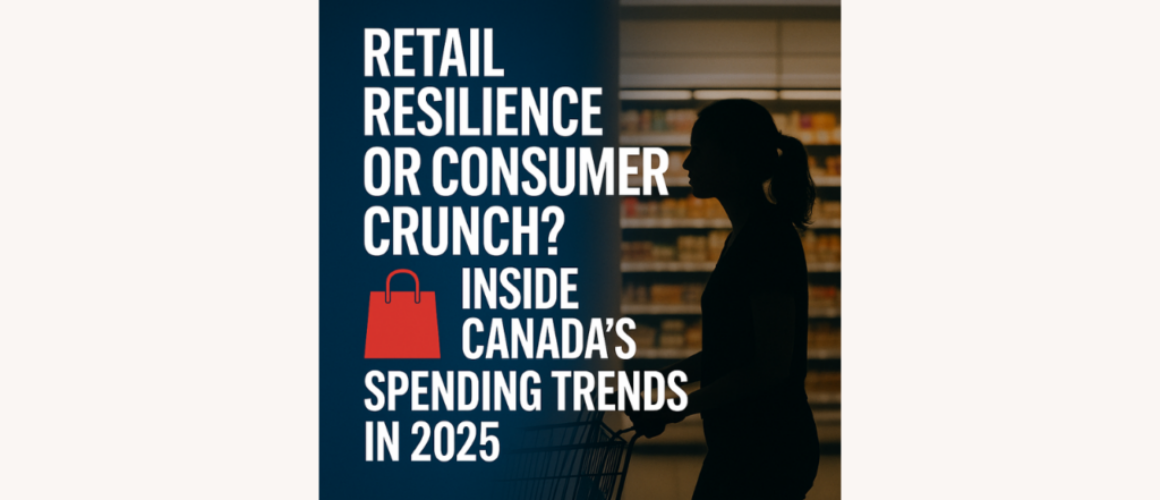Retail Resilience or Consumer Crunch? Inside Canada’s Spending Trends in 2025

As 2025 unfolds, Canada’s consumer economy stands at a crossroads. While malls are bustling and e-commerce volumes remain high, a deeper look at household balance sheets reveals a more cautious, stretched, and uneven retail environment. The question echoing across boardrooms, bank reports, and policy circles alike is clear: Are Canadians truly spending confidently — or merely surviving on credit and delayed consequences?
Recent data from Statistics Canada show a 3.7% increase in retail sales year-over-year, driven largely by groceries, apparel, and home goods. Yet that headline figure masks a fundamental divide: upper-middle income households are fueling discretionary spending, while lower-income groups are cutting back, consolidating debt, and re-prioritizing essentials.
The New Retail Consumer: Divided, Digitized, and Disciplined
Today’s Canadian shopper isn’t impulsive. They’re strategic. Whether in-person or online, consumers are leveraging price trackers, cashback apps, and flexible payment schemes like Buy Now Pay Later (BNPL) with surgical precision. This “disciplined consumerism” reflects both inflation fatigue and digital empowerment.
Retailers like Canadian Tire and Loblaws have reported strong loyalty program enrollment but flat basket sizes — indicating that while Canadians are still shopping, they’re buying less per trip. Meanwhile, e-commerce platforms like Shopify report record conversions from mobile traffic, but lower average cart values — a sign that economic anxiety is tempering convenience-led purchases.
“The psychology of spending has changed,” says retail analyst Corey D’Souza. “Post-pandemic Canadians are wary of inflation, skeptical of brand loyalty, and more focused on value per dollar than ever before.”
Inflation, Interest Rates, and the Ghost of Household Debt
Much of this caution is rooted in persistent economic pressure. Although inflation has slowed to 2.6% from its 2022 peak, it remains stubbornly high for essentials like food and housing. At the same time, interest rates are still elevated, and nearly half of all Canadian mortgages are set to renew between 2025 and 2027 — many at significantly higher rates.
This looming “mortgage cliff” has already changed spending behavior. In suburban Ontario, consumer finance surveys show a sharp uptick in DIY home repairs, meal prep kit usage, and vehicle lease renegotiations. In Alberta, rural households are prioritizing energy-efficient upgrades not just for sustainability — but to manage rising utility costs.
Credit utilization, while still manageable, is creeping upward. According to Equifax Canada, the average non-mortgage debt per consumer hit $22,400 this quarter, the highest since 2019.
Retailers Respond: From Product to Psychology
Smart retailers are not just lowering prices — they’re adjusting entire business models. Hudson’s Bay has shifted focus to limited-time “essential bundles,” while Indigo Books & Music is rebranding select stores into community “experience hubs” with curated local products and free learning events. Walmart Canada recently piloted a “Smart Pantry” app that offers AI-powered suggestions based on price drops and dietary needs.
Retailers are also cutting costs behind the scenes: moving to regional fulfillment centers, negotiating shorter-term leases, and increasing part-time staffing flexibility.
There’s also a growing movement toward “purpose-driven purchasing.” Consumers are rewarding brands with local supply chains, environmental transparency, and accessible pricing tiers. This trend has given rise to dozens of Canadian direct-to-consumer brands focused on sustainability and circular commerce.
The Outlook: Mixed Signals, Measured Optimism
Economists remain divided on what 2025 holds for Canada’s consumer economy. Some forecast a mild slowdown — especially if job growth stalls or mortgage resets hit harder than expected. Others believe that strong immigration, modest wage growth, and technological innovation will offset financial tightening.
The Bank of Canada has so far avoided rate hikes, opting instead for caution and observation. But it has warned that if consumer debt continues to grow faster than disposable income, corrective measures may be required.
In response, Finance Minister Champagne has floated the idea of a “Household Resilience Index” — a national metric to track financial health, consumption volatility, and affordability across income brackets. If implemented, it could reshape how government and industry measure success — beyond GDP and headline sales figures.
Conclusion: Consumption Reimagined
Canada’s consumer economy in 2025 isn’t collapsing — it’s evolving. Canadians are still spending, but doing so with more thought, more tech, and more constraint. Retailers that treat this shift not as a crisis but as a cue for innovation will emerge stronger.
In this era, the question is not whether Canadians will buy — but whether the market will understand how, when, and why they do.